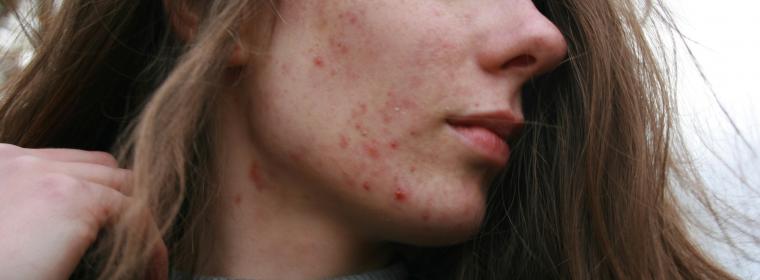
Acne is a chronic condition caused when hair follicles become plugged with dead skin cells and oil (secreted from an attached sebaceous gland.) Although acne most commonly appears in puberty, it can be experienced in adults, as well. Acne typically appears on the face, chest, back, and shoulders, the areas with the largest number of oil glands. Acne can take several forms.
Noninflammatory lesions:
Comedones (whiteheads and blackheads) form when hair follicles become clogged and blocked by oil secretions and dead skin cells.
- When the clog has an opening at the skin's surface, the clog appears dark and "blackheads" form.
- When the clogs are closed at the skin's surface, the clogs appear white or skin color and "whiteheads" are formed.
Inflammatory lesions:
- Papules: are small red and often tender raised bumps indicating inflammation or infection in the hair follicle.
- Pustules: are small red and often tender raised bumps with white pus at the tips of the lesions.
- Nodules: are larger, painful bumps with a component beneath the surface of the skin. These are due to a build up of secretions deep within the hair follicle.
- Cysts: are red, painful, pus-filled lesions, occurring beneath the surface of the skin. These lesions may result in scarring of the skin.
Acne treatments aim at reducing the production of oil from the sebaceous glands, reducing bacterial infection, reducing the inflammation and normalizing skin cell turnover.
Treatment for very mild acne sufferers may include the use of over-the-counter (OTC) products containing benzoyl peroxide or salicylic acid that help dry up facial oil and help slough dead skin cells. These ingredients are found in leave-on lotions, creams and gels, and wash-off cleansers. Although these ingredients may be beneficial for those with mild acne, they can cause irritation, redness or flaking. Benefits may not be seen for four to eight weeks after beginning OTC acne therapy products.
Individuals with moderate acne or for those where OTC products are ineffective, a dermatological evaluation is recommended. The dermatologist may prescribe a topical vitamin A derivative like tretinoin (Retin-A) or adapalene (Differin) that aims at normailizing cell turnover and decreasing oil production to minimize clogging of the hair follicles. Topical antibiotic creams are also used to decrease skin bacteria. A combination of topical products is often prescribed to treat acne.
For moderate to severe acne sufferers, a dermatologist is more likely to prescribe systemic antibiotics to reduce skin bacteria and minimize inflammation. Combination therapy with topical vitamin A derivatives and/or topical benzoyl peroxide may also be prescribed to maximize therapy and minimize antibiotic resisitance.
For severe cases of scarring acne and for those resistant to other forms of therapy, systemic isotretinoin therapy is an option. This powerful medication can be very effective but due to potential side effects, is reserved for the most severe forms of acne.
Tips For Acne Sufferers
- Wash the face with a mild cleanser twice a day to remove excess oil from the skin surface.
- Moisturize the face with a fragrance-free, oil-free moisturizer as frequent facial washing can remove the lipids and proteins that maintain a healthy skin barrier.
- Eat a healthy diet rich with fruits, vegetables and lean protein. Obtain carbohydrates from low glycemic index foods like whole grains, beans and vegetable. Limit high glycemic index foods like white pasta, bread, cakes and cookies.
- Get adequate nights of sleep. Sleep deprivation has been shown in several studies to increase stress and may exacerbate acne.
- Exercise. Studies have shown that moderate exercise can reduce stress and may minimize acne formation. Be sure to hit the showers after heavy sweating to remove the excess oil from the skin's surface.





